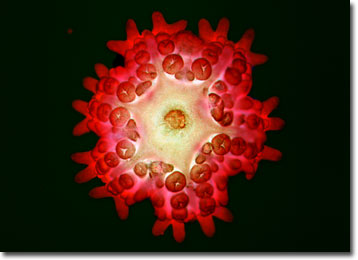Fluorescence Digital Image Gallery
Young Starfish
Starfish, or sea stars, are marine invertebrates that are characterized by radial symmetry, usually possessing five arms that radiate from a central body. If one of the arms is lost, the starfish can easily regenerate a new one to take its place and the separated arm may, likewise, grow into a fully developed individual.

Despite their name, starfish are echinoderms, not fish. They breathe through structures on their hard, spiny skin rather than gills and move through the use of the rows of tube feet that line the bottom of each of their arms instead of swimming. The tube feet are also utilized for detecting smells and tastes, as well as for sweeping food into the mouths of primitive starfish species. Most of the more advanced varieties of the creatures, however, protrude their stomachs out of their mouths to surround prey. When the digestive enzymes secreted by the stomach liquefy the prey, the stomach and food mass are sucked back into the body of the starfish.
Over 1800 species of starfish are known to exist in the oceans of Earth, displaying a variety of colors, shapes, and sizes. They may be fat or thin, big or small, and can exhibit almost any color of a rainbow. One of the largest and most unusual starfish species is the crown-of-thorns, scientifically described as Acanthaster planci. The animal can reach more than 50 centimeters in diameter and has 10 to 20 formidable arms covered in toxic, thorn-like spines. However, even more dangerous in the minds of many scientists and environmentalists, is the crown-of-thorns penchant for coral polyps. In fact, during the 1960s and 1970s, amidst growing concerns that blooms of the echinoderms would lead to the destruction of coral reefs and islands, an attempt was made to control their proliferation, a large number of the animals being destroyed in the process.
BACK TO THE FLUORESCENCE DIGITAL IMAGE GALLERY
